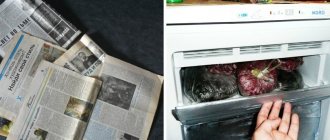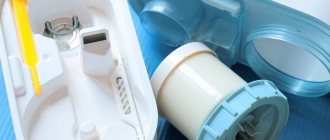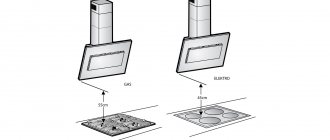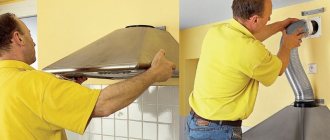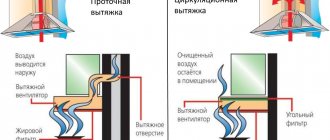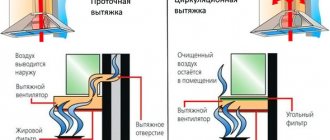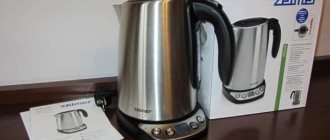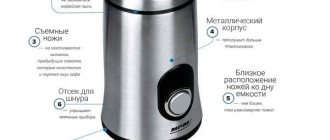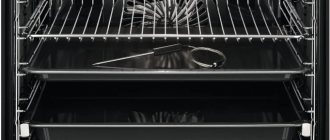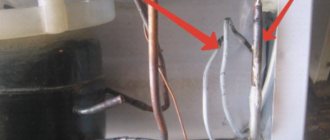Reasons for a clogged hood and preparation
There is always a lot of steam, fats and odors in the kitchen. The hood above the gas stove draws all this into itself and gradually its grate becomes covered with a layer of fat that is not so easy to wash off. If the grate is not cleaned, then over time the efficiency of the hood will greatly decrease and it will be of no use. There are 6 main ways to help clean it in your apartment at home.
Before you start cleaning the hood grille, you need to prepare everything correctly. First of all, it must be disconnected from the power supply and completely disassembled. To choose the right detergent and thoroughly clean the kitchen hood from grease, you should look at the instructions. The manufacturer always indicates what is suitable for cleaning. An incorrectly selected product may cause damage to the surface.
Preparation stages:
- Remove the front panel. It is most often attached with latches. There are models where the panel is attached with bolts. The panel can be washed with regular detergent and a cloth.
- Remove the grille (filter) for soaking in a soapy solution and then cleaning.
- Separate the pipe (corrugation) and clean it of cobwebs and grease.
- If possible, completely remove the housing and wipe off dust and other contaminants from the inside and outside.
- On some models, the air filter can be removed. It is worth reading the instructions carefully before removing.
All elements are removed and cleaned of significant contamination. If all parts are not very dirty, you can wash only the filter.
How to clean a kitchen hood from grease using a steam generator or dishwasher
To clean the hood and its components from carbon deposits, you will have to remove them from the hood, then place them in the dishwasher container. Then add detergent: in this case, Finish tablets will be effective. They not only cope with a thick layer of fat, but also eliminate unpleasant odors.
Slightly ingrained carbon deposits can be removed using a powerful washing vacuum cleaner. If you have a steam generator in your home, just remove the parts from the electrical appliance and place it in the bathroom. Next, you need to treat the grates with a powerful stream of steam. After that, just wash with detergent and a sponge, then rinse in cold water.
Why should you clean and how often?
During intensive cooking, the kitchen is literally saturated with steam and various pungent odors. Plaque, consisting of an accumulation of droplets of fat, settles on all surfaces, so you simply cannot do without a hood. However, the device is only effective if it is clean .
Drawing in all the fumes, the hood grate, which is located directly above the gas stove, gradually becomes covered with a thick layer of fat. And washing it at home quickly and effectively is very problematic.
IMPORTANT! If you do not clean the device for a long time, then over time its efficiency will significantly decrease.
The fan blades, air duct, and filters will become covered with grease, soot, dust, become dull and will no longer allow air to pass through. Therefore, soon microparticles of contaminants will freely scatter throughout the room and settle on the kitchen furniture, windows, walls and even the ceiling. Sticky plaque will give the kitchen interior an unpresentable look.
Also, during operation of the hood, the noise level will increase, and over time, not only the appearance of the housing, but also the parts will deteriorate. As a result, after a short time the device will fail.
The frequency of basic cleaning of metal air intake grilles depends directly on the intensity of its use. Ideally, cleaning should be done once every 30 days , if the activity of kitchen processes is above average - twice a month. If you rarely cook in the kitchen, then the frequency of cleaning can be reduced to once every 2-3 months.
By following this simple rule, you can spend a minimum of time on the cleaning process. Small deposits can be easily washed off with improvised means, while dealing with more serious stains will require a lot of effort and professional means.
There is no point in washing disposable filters made from synthetic materials and their carbon analogues. They need to be replaced with new ones. The exact service life of individual parts depends on the brand of the product and is indicated in the instructions for the device.
As a rule, disposable grease filters made from padding polyester, paper, acrylic or non-woven fabric must be replaced every 4 months . Circular hoods are equipped with a carbon filter, which only needs to be changed once every six months.
Don’t forget about the unit’s motor. It is recommended to lubricate it every two years.
How to disassemble a hood for cleaning
The hood is an important assistant in the kitchen; it must be kept clean. Improper care leads to moisture and odors. The frequency of cleaning depends on the intensity of use of the device. It is recommended to adhere to the following deadlines:
- weekly cleaning of kitchens in public catering establishments;
- Clean your home hood every 1-3 months.
Don’t delay cleaning - removing old grease and carbon deposits is difficult and time-consuming.
Before cleaning, you must unplug the equipment and disassemble it. Study the technical documentation to determine the nuances of removing individual sections. Prepare a container for removable parts, kitchen furniture and clear the working surface of the stove.
Parsing scheme:
- Release the retaining clips.
- Remove the grille from the grooves.
- Unscrew the mounting bolts.
- Remove the filter. In some models it is hidden behind a metal grille.
- Remove the pipe.
- Remove the air filter inside if your unit has one.
Inspect the parts to assess the extent of contamination and select a grease cleaning option.
What can't you clean?
The surface of the hood and built-in filters is made of metal alloys. Therefore, not all aggressive substances can be used to clean parts. Some products may react with the metal, causing permanent stains, clouding and tarnishing.
It is not recommended to use the following for cleaning a fume hood:
- concentrated alcohol;
- acetone-containing compounds;
- nail polish remover;
- any solvents.
IMPORTANT!
To clean the surface of the case, do not use powdered products, which may leave scratches. Hard iron jaws or scrapers are also contraindicated.
Common Mistakes
What NOT to do if you clean the hood yourself:
- Turn on the device immediately after washing if you cleaned the inside of the housing. The fan and motor must dry out.
- Wash the disposable filter. They only need to be replaced.
- Clean the plastic filter with steam or pour boiling water over it. High temperatures can deform plastic.
- Use stiff brushes, abrasive cleaners and steel wool to clean the exterior of the cabinet. A smooth surface can be scratched, especially if you rub hard.
- Use alkaline cleaners to clean aluminum filters.
- Use alcohol-containing detergents and solvents to clean the cabinet. After such cleaning, the surface may become dull.
About the most popular hoods in Russia: Elikor products
Where to make a socket for a hood in the kitchen: placement rules
Related Posts
Preparation
The hood should be cleaned after disassembling it into its component parts. Before doing this, you need to read the instructions for the device. Then turn off the hood from the electrical network and proceed sequentially:
- Open the case by unlocking the latches.
- Remove the filter.
- Remove the exhaust pipe. It is important to pay attention to what it is made of. Not every material can be washed. Information about this can be found in the instructions for the hood.
- Then wash each part, along with the body itself, in the bathroom, first soaking it in a solution with detergent.
Don't forget that the surface of the hood also needs to be cleaned. The washing solution is prepared in a ratio of 1:4, where water accounts for four parts, and a cleaning agent, for example Fairy, accounts for 1. A regular sponge is used for cleaning. Afterwards, all structural elements are wiped dry.
Preparing the hood for cleaning and washing - what is important?
Considering that a range hood is not a pan, but a household appliance that cannot simply be put in the sink and washed, first of all we study the instructions.
- We disconnect the equipment from the network.
- We disassemble what, according to the instructions, can be disassembled.
- We remove the protective surface of the equipment.
- We take out the filter.
- We soak all removable parts.
- At the same time, we unscrew the pipe that removes dirty air through the hood and further into the ventilation. It also needs cleaning!
- We check the hood body for contamination.
How to wash the probe?
The probe is the main working part of the exhaust device , which is responsible for capturing fats and fumes. It is this part that gets dirty the fastest and requires effective cleaning measures.
Treating the mesh with soda solution
Baking soda is a universal substance suitable for removing most stains in the kitchen. It effectively breaks down fats, and at the same time allows you to save on expensive household chemicals.
Instructions for use:
- Prepare a spacious basin - the grilles and filter should completely fit into it.
- Pour 5 liters of water into a basin and boil on the stove.
- After boiling, add 0.5 cups of baking soda and reduce the heat to low, making sure that the liquid does not stop boiling.
- Place a filter with grids in boiling water and boil for 5 minutes.
- After 5 minutes, check how well the fat is removed. For old stains, continue boiling for another 5-10 minutes.
- Remove the parts from the basin, cool slightly and wash with soap and then running water.
Advice! If you don’t have a large boiling container, place the grates vertically and boil on both sides in turn.
Soda is an easy and simple way to clean grease from your microwave.
Treatment of neglected plaque with ammonia
Ammonia works well for ingrained fat, which even boiling soda cannot get rid of. Cleaning is carried out by soaking.
They work in a mask, since ammonia has a pungent odor and acts as an aggressive irritant for the mucous membranes.
How to clean:
- Dilute 0.5 cups of ammonia in 3.5 liters of hot water.
- Dip dirty grates into the solution and leave to soak for 1-1.5 hours. If boiling water is used, soaking is reduced to 5-10 minutes.
- Softened fat deposits are cleaned off with the hard side of a sponge or a soft scraper, and the parts are washed under running water.
Advice! Do not forget to open the window for ventilation during hygiene measures so that ammonia can ventilate.
Method 5. How to wash the hood with laundry soap
Laundry soap does an excellent job of removing grease, especially when combined with hot water.
Instructions:
- Heat 2.5 liters of water in a saucepan/basin.
- Grate half of the laundry soap (72%) on a medium grater and add to heated water.
- When the soap has dissolved, remove the bowl from the heat, immerse the filter in it and leave to soak for 10-20 minutes.
- Clean the grill as usual.
Adviсe:
- You can wipe the hood body with the same soap solution.
- To increase the effectiveness of the soap solution, add a couple of tablespoons of baking soda to it.
Household chemicals for cleaning hoods
Professional products are used for old stains. If the hood has not been treated for more than six months, home methods cannot cope with the problem. The following products are needed: Fairy, Shumanit, Green&Clean Professional, AmWay, Sano Forte Plus, Topperr, Mister Muscle, Silit Banks, Mole. They certainly have their advantages: they are narrowly targeted (they act on a specific type of pollution), require virtually no effort, and are used economically. But at the same time, these solutions can be aggressive towards metal and other materials from which the hood is made.
When using them, you need to wear gloves on your hands. You will also need sponges, rags, and a towel.
The method of processing components does not require more than 10 minutes and consists of soaking the hood parts in professionally prepared solutions. If there are no contraindications in the instructions, you can wash the grill and accessories in the dishwasher.
The mole cleaning method is considered the most radical. It can be used a maximum of a couple of times during the entire service life of the hood. It involves immersing the parts in Mole's solution (be sure to wear gloves while doing this). The reaction begins immediately. After treatment, you need to rinse the hood parts under running water for a long time. The alkali contained in the product should not remain on the components; it “eats” the metal.
Overview of household cleaning products
Store-bought dishwasher and stove cleaners work well to remove grease from the hood.
Among the variety of household chemicals, the following drugs have proven themselves well:
- Spray “1 minute”, Sanita (Russia);
- Spray "Anti-Fat", Cinderella (Russia);
- Gel “Synergetic” (Germany);
- Spray and gel “Anti-Fat + Radiance”, Cilit Bang (Poland);
- Gel and spray “Shumanit”, Baghi (Israel).
Spray Sanita
A fast-acting product with active ingredients “corrodes” fat accumulations, plaque and other types of dirt in a matter of minutes. Express spray is considered one of the leaders due to its versatility and affordable cost.
Sanita spray is not intended for cleaning varnished, enameled, aluminum and painted surfaces.
Area of use: caring for kitchen equipment, furniture, blinds, plastic panels, tiles and dishes. The approximate cost of the bottle is 2.5 USD.
Cinderella "Anti-Fat"
An affordable, effective product that gently cleanses stubborn stains. Suitable for use on different types of surfaces after test use on a small area.
Before use, the sprayer valve must be turned to the “open” position and the surface should be sprayed. After 20-25 minutes, remove dirt with a brush.
Price for 500 ml – 2-2.4 USD Among the disadvantages, users note a very liquid consistency and rapid consumption.
The main active ingredient of the Anti-Fat spray is soda. The natural cleaner does not act as quickly as chemical reagents, but the substance is safe
Synergetic for slabs
The gel-like product is positioned as a safe, natural preparation for cleaning stoves, ovens, frying pans and baking trays. It contains no harsh chemicals and is 100% biodegradable.
Limitations of use: surfaces made of brass, copper and copper alloys, as well as aluminum. Despite the safety, you should use gloves when working - they will protect your hands from drying out. Average cost – 10 USD/1 liter.
Range of action: soot, carbon deposits, grease, oil stains, scale and rust. Excellent for cleaning air intake grilles
Household chemicals Cilit Bang
Gels and spray “Anti-Fat + Shine” are a Polish development for removing burnt and greasy stains in the kitchen. Grease removers are made on the basis of surfactants, due to which they have a “soft” effect on dirt. There are no abrasives in the composition.
The drug is easy to use, spreads well on the surface and is optimal for timely care. The cost of “Anti-Fat + Radiance” is 6 USD/750 ml.
In practice, Anti-Fat + Shine has shown its effectiveness in the fight against “fresh” drops of fat and soot stains. The product is almost powerless against limescale, hard deposits, and old rust.
"Shumanit" from Baga
Professional chemistry for easy removal of fat from surfaces involved in food preparation. “Shumanit” is a potent remedy, and therefore requires strict safety measures during use.
Distinctive features:
- no abrasive additives;
- antibacterial effect;
- fast action - the first effect is noticeable 5 minutes after applying the drug;
- effective cleansing of old fat accumulations;
- economical consumption.
The product is not suitable for cleaning aluminum or painted surfaces. Cost – 4.5 USD/500 ml.
“Shumanite” is toxic and has a specific pungent odor. Work must be carried out wearing a gauze bandage or a respirator. A prerequisite is sufficient ventilation
Time to wash the hood
Maintaining cleanliness in the kitchen is a process the frequency of which each housewife chooses for herself. Some people wash everything inside and out every day, while others limit themselves to everyday dishwashing and carry out general cleaning once a quarter.
Indeed, not all things in the kitchen require daily cleaning, and the hood is one of them. However, you need to understand when it’s time to wash the hood and with what regularity it should be done, so that you don’t waste a lot of time and effort cleaning old dirt:
- if you cook quite often using a hood, then the filter should be cleaned at least once every two weeks;
- If the intensity of cooking is not very high, then cleaning once a month is enough.
If traces of dirt are noticeable on the outside of the exhaust surface, the filter is covered with grease ahead of schedule, and odors are poorly removed from the kitchen, then it’s time to start cleaning without waiting for the allotted time.
Not everything in the kitchen requires daily cleaning
But in any case, do not forget to do general cleaning of the hood at least once a quarter, washing all its components.
Features of cleaning a stainless steel hood
You probably know that not all methods are suitable for stainless steel. She is afraid not only of products containing alkali, but also of abrasive powders and even salt, which cause corrosion on such a surface. But the following products will cope well with grease and dirt on stainless steel:
- soap solution;
- vinegar solution in a ratio of no more than 1:1;
- lemon;
- special products for cleaning stainless steel.
Not all products are suitable for cleaning stainless steel hoods.
Use the first 3 products in the same way as described in the methods above, and use special ones strictly following the instructions on the package.
Methods for cleaning various parts of the hood
A kitchen hood has the following components: an air duct, a mesh, in some cases a filter, a motor, a fan, a case and a button panel. Washing only the body with buttons is ineffective. It is necessary to completely clean the hood at least once a quarter in order for it to serve effectively and for a long time.
Filter
There are two models for operating the hood: using a filter (preferably) and without it (in this case, the air duct can become very dirty and require complete replacement over time). If you use a filter, it should be changed as it wears out. The instructions indicate the expiration date of the cartridge.
Net
The most popular solution is baking soda and salt. With this method of cleaning, you need a large container into which you need to pour the cleaning solution and put it on the fire. The mesh is placed there for 2-3 hours. If there is no such container, then you will have to boil one side first, then the other.
Such cleaning requires time and good ventilation of the room. For better results, after boiling, you can clean the mesh with a soft bristle brush. It's even better to put it in the dishwasher. Housewives have recently preferred soaking in Coca-Cola to this method. It dissolves fat without residue and requires no effort other than rinsing.
Fan and motor
The engine is the basis of normal air exchange
You need to treat it with caution and care. And most importantly - wisely
You should not touch it more than several times a year. According to the instructions, you need to determine the location of the working elements and get them. The fan and motor are always paired. They need to be separated. Then prepare the selected solution from those listed above and soak the fan blades in it for an hour. After 60 minutes, wipe off the dissolved fat with a sponge or rag, rinse under the drain and dry well.
Air pipe
The air duct is responsible for draft and affects the quality of air exchange in the kitchen. Its function is especially important if there is smoking there. The exhaust shaft must be changed periodically. Modern air pipes are produced in two types: plastic of various shapes and corrugated. Plastic ones are easy to clean: take them apart, soak them in a special solution, wash them, and dry them.
It’s more difficult with corrugated ones. They must be changed once a year or treated with a steam cleaner. Only after this the air duct is washed with soapy water and dried. The steam cleaner can also be used to clean the fan, grille, and motor. The corrugation is cleaned with Mole, soaking it for half an hour in the prepared solution. Sometimes the procedure requires repetition. Then the same washing and drying.
Frame
It's decor and easy to clean. The sponge is moistened in the solution selected and prepared in advance and wiped. Then remove the residue with a damp cloth and wipe dry with a towel. If laziness has led to the accumulation of fatty deposits, a general cleansing is necessary. To do this you need:
- Turn off the gas.
- Clean the housing with Schumanite or its equivalent. A combination home remedy may be used.
- Wipe with a soft sponge. Metal abrasives are excluded; they scratch the body.
- Dry.
Buttons and inner walls
Special sprays are produced for their surfaces, but they can also be replaced with traditional solutions. The idea is to spray the buttons on the panel and wipe them dry with a clean cloth. Internal surfaces are treated with a combination of products: from grease and dirt, from odor and soot. Glass inserts must be cleaned in the same way.
Last resort: use a professional drain cleaner
It happens that it is not possible to cope with cleaning the hood, namely the filter, using the means described above, as the contamination turns out to be so complex. There is one way that will help even in this case.
- Purchase a special product at the store for clearing blockages in pipes. You will also need a metal container of a suitable size, such as a stainless steel sink.
- Read the instructions on the package carefully. Strictly following it, prepare the remedy.
- Wear rubber gloves. Close the sink drain, pour in the prepared product and place the filter there.
- You will see how the product begins to react with the fat on the filter. When all contaminants have dissolved, rinse the filter under running water for as long as possible so that the remaining dirt and special product completely disappear.
Sometimes, in particularly severe cases, only pipe cleaners can help.
Note! The active ingredient in pipe cleaners is alkali, which is aggressive to metal surfaces. Therefore, you can clean the hood with them no more than 2 times during the entire operation of the device, only as a last resort.
Why you need to clean your kitchen hood and how often you should do this procedure
A ventilation hood should be present in every home kitchen. Mount it above a gas or electric stove. The device plays an important function indoors by drawing harmful fumes and odors from cooking outside.
A properly installed and configured hood can even remove a gas leak from the stove to the street if something accidentally escapes
However, in order for the device to work properly for a long time, it is necessary to ensure its cleanliness. Regularly wash filters, grilles, controls and housing to remove drops of oil and grease. Unfortunately, modern women do not always have enough time for this, so they are faced with a problem when they try to clean the kitchen hood. This happens because a large layer of fat accumulates on the filters and motor blades over a long period of time, on which dust settles. Such contamination is difficult to remove, so it is recommended to thoroughly wash all components of the electrical appliance twice a month.
Why is it recommended to clean your hood regularly?
When you enter an apartment, the first thing you notice is the decor and cleanliness.
This is especially true for the kitchen, because you want to eat or even drink tea not only in a comfortable atmosphere, but also in a tidy room where order is maintained. Of course, guests will not look at every corner in search of dirt, but it is the hood that often catches the eye. The main task of this equipment is to clean the air from odors, which causes grease to accumulate on the surface, on which dust settles. As a result of this process, the hood becomes covered with a dense layer of dirt, which immediately spoils its appearance. While in the kitchen it is necessary to maintain a cozy atmosphere so that nothing distracts from a delicious lunch.
Find out how to wash horizontal aluminum blinds by reading the recommendations in a special article on our website.
With regular cooking, a sticky residue collects on the surface of the hood
. However, it's not just about the appearance of the equipment. The main problem is that due to the thick layer of dirt, the hood does not work properly. Sometimes fat gets not only into the mesh, but also into the internal structural elements, which leads to their breakage.
You can tell if your device needs cleaning by the following signs:
- if there is a dirt detection sensor, it will light up and show a grille icon;
- the hood will stop functioning normally, an extraneous sound will appear, and the smell will not disappear during cooking (in some cases, odors are eliminated, but slowly);
- You can visually see the presence of sticky marks on the filter, which should be a reason to wash it.
To ensure regular operation of the exhaust system, it is necessary to keep the equipment clean
It should be remembered that even if you cook often or for a long time in the kitchen, any odors and fumes should be quickly eliminated. If this does not happen, then you should definitely check the functionality of the exhaust system.
How often should you clean your hood?
Features of cleaning stainless steel equipment
Everyone has long known that not every method is suitable for cleaning stainless steel products - such a surface can be easily damaged by hard sponges, granular products, aggressive alkali and even salt.
However, it is allowed to clean stainless steel with the following means:
- soap;
- a weak solution of vinegar;
- lemon juice.
On sale you can find special products for the care of stainless steel products.
Traditional methods are recommended to be used in the instructions that we have reviewed, and chemical agents only in compliance with the algorithm specified by the manufacturer.
Prices for kitchen hoods
Kitchen hoods
How to care for your hood?
Following preventive recommendations will help avoid the accumulation of a layer of fatty plaque:
- if you purchase a new device, the installation must be entrusted to a professional technician, because the equipment should be installed at the optimal distance, and not by eye;
- if you are not using the stove, do not forget to turn off the burners;
- When frying any food in a frying pan, you must use a protective “screen” from splashes;
- You should wash and wipe all parts of the hood as often as possible.
Regular cleaning of the structure will help avoid stubborn stains.
Preparing to wash
If you decide to carry out a major cleaning of the exhaust system, you will need to perform the following steps:
- disconnect the device from the power supply, otherwise you risk getting an electric shock;
- disassemble the structure into parts.
Traces of fat on internal parts
You should be careful with the second point - it is recommended that you first read the instructions that the manufacturer encloses with the package. Information regarding the materials of all parts should also be indicated there so that you know which cleaning products are acceptable to use. However, most models have similar internal contents.
Hood disassembly sequence:
- First you need to dismantle the cover: to do this, unclip the fixing parts and remove it.
- Now you need to pull out the filter grid.
- Next, you will have to dismantle the pipe that extends from the hood.
- The last step is to remove the air filter.
It is necessary to disassemble the hood following the specified sequence
After disassembly, each part of the structure must be immersed in water to make it easier to remove dirt later. It is also necessary to thoroughly clean the inside of the base of the hood.
Note! Before you begin the procedure for cleaning the structure, you need to cover the hob and furniture that is located nearby with foil, because during the cleaning process, grease may drip down. In addition, the structure can be assembled and turned on after the parts have completely dried.
Folk remedies against pollution
If you don’t have a professional cleaning product at hand, then you can use traditional methods, which have not lost their popularity for many years in a row. In this case, you will have to prepare the following:
- laundry soap;
- acetic acid;
- lemon juice;
- soda
Every housewife can cope with the preparation of a folk remedy for cleaning fat deposits
Using soap: step-by-step instructions
It is worth noting that in addition to one piece of laundry soap, various devices will be required during the work: washcloths, sponges, rags.
Step one: First you need to grind the soap (you can cut it into pieces), and then place it in a container with water at a temperature of at least 45 degrees. If desired, you can also add a little liquid soap and washing powder. The amount of the above products will depend on the complexity of the contamination.
You will need to take at least 70% laundry soap
Step two: place the filter from the hood in the container with the solution and leave for half an hour.
The container must match the dimensions of the filter
Step three: while the filter is soaking, you need to soak a sponge in this solution and wipe the body of the exhaust system with the hard side.
If dirt remains on the grill, you can remove it with a steel wool
Step four: after half an hour, you need to take out the filter and use the same sponge to remove any remaining grease.
Upon completion of cleaning, the filter should be dried and only then installed.
Using lemons: step-by-step instructions
The main advantage of this method is that after the procedure you will not feel a strong chemical smell, but only a pleasant citrus aroma. But, it is worth noting that “lemon peeling” is not suitable for people who have a severe allergy to citrus fruits.
Step one: first you need to take two lemons, cut them into halves and squeeze out the juice.
Carefully squeeze the lemon juice using a special device.
Step two: now you should take a rag, soak it in lemon juice and wipe the filter generously. It is left in this form for 20 minutes.
You will need to thoroughly saturate the grate with juice.
Step three: the remaining grease must be removed with a damp sponge, after which the grate should be left to dry.
It is necessary to vigorously wipe dirt to remove it from the surface.
Using soda: step-by-step instructions
Baking soda is one of the popular products that is used not only to clean kitchen equipment, but also dishes. In addition, it is an environmentally friendly and respiratory-safe product that can be used without fear.
Step one: you will need to prepare a large saucepan, then fill it with about two-thirds of water and put it on the fire.
The water should be brought to a boil
Step two: add about one cup of baking soda to boiling water, after which you need to reduce the heat to low.
If desired, you can add more soda, especially if there are a lot of contaminants.
Step three: now you need to place the grate from the exhaust system and the filter into this pan. While the liquid is boiling, the fat will have time to dissolve.
The hood parts should be “cooked” over a fire for ten minutes
Step four: after some time, you need to take out the parts and look at their appearance. If there are traces of fat left, then in molten form they will be easy to remove under the pressure of warm water. If there are still impurities that cannot be removed, the grate should be “boiled” for a couple more minutes. Once cleaning is complete, all these parts must be dried.
Remaining fat quickly disappears under running water
Step five: now you need to take an unnecessary toothbrush and use it to go through all the corners of the grate where particles of fat could remain.
The result of cleaning the filter grid with baking soda
Note! You can increase the effectiveness of soda if you add a little washing powder to boiling water in addition to the main component.
Using vinegar: step-by-step instructions
Before using acetic acid to clean household appliances, you must open the windows in the room - this substance emits fumes with a pungent odor that can make you dizzy.
Step one: apply vinegar to the sponge, and then walk the hard side of it over the grate.
Vinegar is active for 20 minutes
Step two: after some time, you need to take a stiff brush and remove any remaining grease.
For greater efficiency, it is recommended to use dishwashing detergent
Video - Cleaning the hood without chemicals
Useful tips for the hostess
Before carrying out the procedures, remember the rules:
- do not wash the replacement filter, it needs to be changed, otherwise the device will not work well;
- do not boil plastic parts;
- do not use metal mesh or abrasive powders for cleaning;
- do not clean aluminum filters with alkali;
- ventilate the kitchen after cleaning.
Cleanliness in the kitchen is very important for any housewife. We can say that the methods described in the article are suitable not only for cleaning hoods. Vinegar, citric acid and soda are used to clean a wide variety of surfaces. To make your kitchen shine, read the rules for cleaning a gas stove and its electric counterpart, a multicooker, and a microwave. Many people do not suspect, but the dishwasher also needs regular cleaning, and our article will tell you how to do it correctly.
